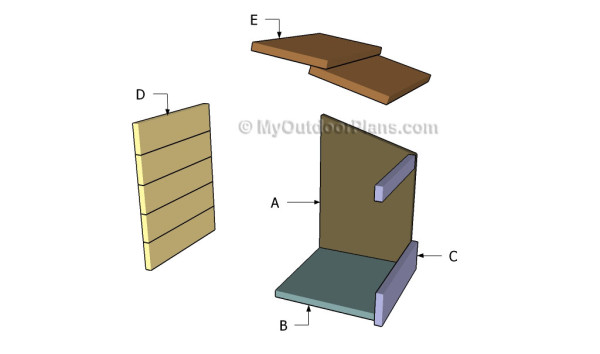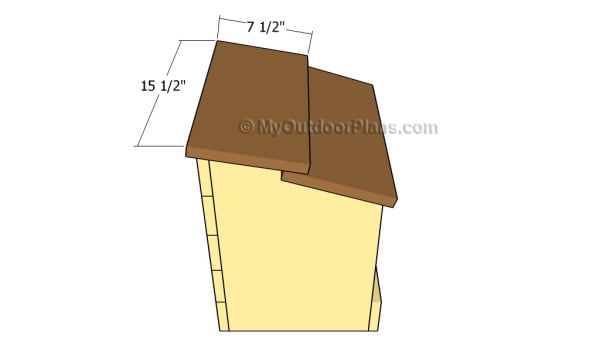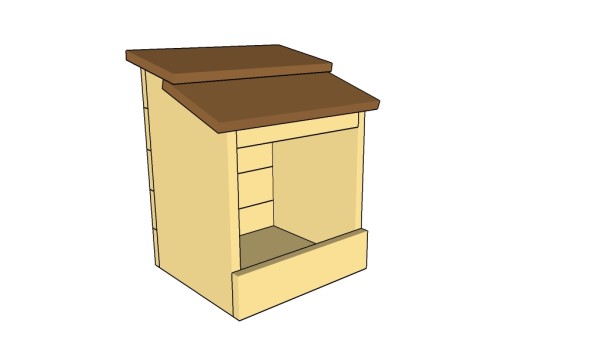This step by step diy woodworking project is about nesting box plans. If you want to learn more about building a nesting box, we recommend you to pay attention to the instructions described in the article. There are many other designs and plans to choose from when building projects for your backyard, so make sure you take a close look over the related plans that are featured on our site.
There are many plans and designs to choose from, so make sure you take a close look over the rest of the chicken coop plans featured on our website. Plan everything with attention and adjust the size and the shape of the patio table to suit your needs. Plumb the legs and make sure the corners are right-angled before inserting the galvanized screws into place. Drill pilot or pocket holes to prevent the wood from splitting. See all my Premium Plans HERE.
Projects made from these plans
Nesting Box Plans

Building the nesting box
Cut & Shopping Lists
- A – 2 pieces of 1×12 lumber – 17 1/2″ long SIDES
- B – 1 pieces of 1×12 lumber – 12″ long BOTTOM
- C – 1 piece of 1×2 lumber – 12″ long, 1 piece of 1×4 lumber – 13 1/2″ long SUPPORTS
- D – 5 pieces of 1×4 lumber – 13 1/2″ long BACK
- E – 2 pieces of 1×8 lumber – 15 1/2″ long ROOF
- 1 piece of 1×12 lumber – 4 ft
- 1 piece of 1×2 lumber – 1 ft
- 1 piece of 1×4 lumber – 8 ft
- 1 piece of 1×8 lumber – 3 ft
- 2 1/2″ screws
- 1 5/8″ screws
- 1 1/4″ screws
- wood filler
- wood glue
- stain/paint
Tools
![]() Hammer, Tape measure, Framing square, Level
Hammer, Tape measure, Framing square, Level
![]() Miter saw, Drill machinery, Screwdriver, Sander
Miter saw, Drill machinery, Screwdriver, Sander
Time
Related
Building a nesting box

Building the side components
The first step of the woodworking project is to build the sides of the nesting box. Therefore, we recommend you to mark the cut lines on the 1×12 slats, making sure the dimensions are highly accurate.
Smooth the cut edges with sandpaper and remove the residues before continuing the outdoor project. Make sure the other side has the same dimensions and shape, otherwise the end result won’t be professional.

Fitting the bottom
Cut the bottom of the nesting box out of 1×12 lumber. Attach the sides to the bottom, drill pilot holes and insert 1 1/4″ screws. Add waterproof glue to the joints and make sure the corners are right-angled.

Fitting the front supports
Continue the woodworking project by fitting the supports to the front face of the nesting box. Therefore, we recommend you to drill pocket holes at both ends of the 1×2 supports and to attach it to the sides of the box by inserting 1 1/2″ screws.
In addition, fit a 1×4 slat to the nesting box, in order to create a rigid and durable structure. Leave no gaps between the components and make sure the screws are inserted properly.

Attaching the back slats
Attach the 1×4 slats to the back of the nesting box, making sure you leave no gaps between them. Work with attention and align the slats at both ends before inserting the 1 1/4″ screws. Drill pilot holes to prevent the wood from splitting and add glue to enhance the rigidity of the structure.

Fitting the roofing slats
Building the roof for the nesting box is a straight forward process, as you just need to attach two pieces of 1×8 lumber to the frame. Work with attention and take accurate measurements if you want to get a professional result.

Nesting box plans
One of the last steps of the woodworking project is to take care of the finishing touches. Therefore, fill the pilot holes with wood putty and smooth the surface with 120-grit sandpaper.
Top Tip: If you want to enhance the look of the woodworking project and to protect the table from decay, we recommend you to cover the components with paint or stain. Place the box in a proper location and move it whenever necessary.
This woodworking project was about nesting box plans. If you want to see more outdoor plans, we recommend you to check out the rest of our step by step projects. LIKE us on Facebook and Google + to be the first that gets out latest projects. LIKE us on Facebook to be the first that gets our latest updates and submit pictures with your DIY projects.
